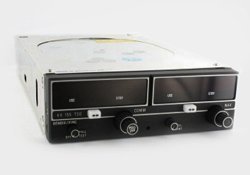 will be closed December 24th - January 2nd for the Holidays.
will be closed December 24th - January 2nd for the Holidays.
Regular business hours will resume on Monday, January 5th.
AOG Services are available.
| Part #: | 064-1051-70 |
|---|---|
| Model: | KY-97A |
| Desc: | VHF Comm Transceiver |
| OEM: | BendixKing |
| NSN: | |
|---|---|
| Sched-B: | 8525601055 |
| ECCN: | 7A994 |
 Select part number above to view pricing and availability.
Select part number above to view pricing and availability.
| Price | Condition | Availability | Stock Info | |
|---|---|---|---|---|
| Price | Cond. | Avail. | Stock Info | |
| REQUEST | OH OUTRIGHT | REQUEST LEAD TIME |
|
| Price | Condition | Availability | Stock Info | |
|---|---|---|---|---|
| Price | Cond. | Avail. | Stock Info | |
| REQUEST | SV OUTRIGHT | REQUEST LEAD TIME |
|

FEATURES
SPECIFICATIONS
| Size: | 6.25"W x 1.3"H x 10.50"L | Weight: | 2.9 lbs. |
| TSO Compliance (Transmitter): | TSO C37c, Class 4 | TSO Compliance (Receiver): | TSO C38c, Class C & D (-60 model); TSO C38c, Class A & B (-61 model) |
| Power Output: | 5 Watts min. | 1 minute on, 4 minutes off 118.00 to 136.975MHz in 25KHz | 1 minute on, 4 minutes off |
| Temperature Range: | -20 to +55C | Frequency Range: | 118.00 to 136.975MHz in 25KHz increments |
| Modualtion: | 70% modulation with 90% limiting. Less than 15% distortion at 70% modulation | Receiver Sensitivity: | 2uV (hard) or less for 6dB S+N/N with 1KHz tone modulated 30% |
| Part Number | Description |
|---|---|
| 064-1051-10 | 25Khz receiver selectivity, 500ohm headphone audio output, 720 channels |
| 064-1051-30 | 25Khz receiver selectivity, 500ohm headphone audio output, 760 channels |
| 064-1051-50 | 25Khz receiver selectivity, 4W into 4ohm audio output, 720 channels |
| 064-1051-51 | 50Khz receiver selectivity, 4W into 4ohm audio output, 720 channels |
| 064-1051-60 | 25Khz receiver selectivity, 4W into 4ohm audio output, 760 channels |
| 064-1051-61 | 50Khz receiver selectivity, 4W into 4ohm audio output, 760 channels |
| 064-1051-70 | Crown series version of -60 unit with solid black face and no silver lining trim |
PLEASE NOTE: THE ABOVE LISTED PART NUMBERS REFLECT THE DIFFERENT UNITS ORIGINALLY AVAILABLE BY THE MANUFACTURER AND DO NOT NECESSARILY INDICATE OR REFLECT THE CURRENT AVAILBILITY OF THESE DIFFERENT UNITS BY SOUTHEAST AEROSPACE OR THE AFTERMARKET
| Price | Condition | Status |
|---|---|---|
| REQUEST | OH OUTRIGHT | REQUEST LEAD TIME |
| Price | Condition | Status |
|---|---|---|
| REQUEST | SV OUTRIGHT | REQUEST LEAD TIME |
Click on a question below to see the answer. If you have a question about this model that is not answered below, please contact questions@seaerospace.com
In relation to NE (New) parts, many OEMs change their prices and availability without any notice to dealers or the industry. Therefore, through the REQUEST or RFQ indication, we ask that customers contact us for the most accurate price and availability.
In relation to SV & OH parts, the used parts aftermarket in the aviation industry is not an infinite supply. It is a dynamic, constantly changing market that is significantly affected by and susceptible to highs and lows in supply and demand. Therefore, although we attempt to, at times, we are unable to predict the exact moment when an item may be available. Once again, through the REQUEST or RFQ indication on our website, we ask that customers contact us for the most current and accurate price and availability.
| Navigation (Nav) and Communication (Comm) radio receivers and transceivers are available as separate, individual radios or as a combined Nav/Comm unit. A Nav/Comm unit is sometimes more economical in price than the 2 separate Nav and Comm radios and usually requires less panel space. Obviously, one disadvantage to the combined Nav/Comm unit is in the case of unit failure you lose both nav and comm functions since the entire unit is removed. |
KN-53 Nav: KY-196A Comm:  KX-155 Nav/Comm:  |